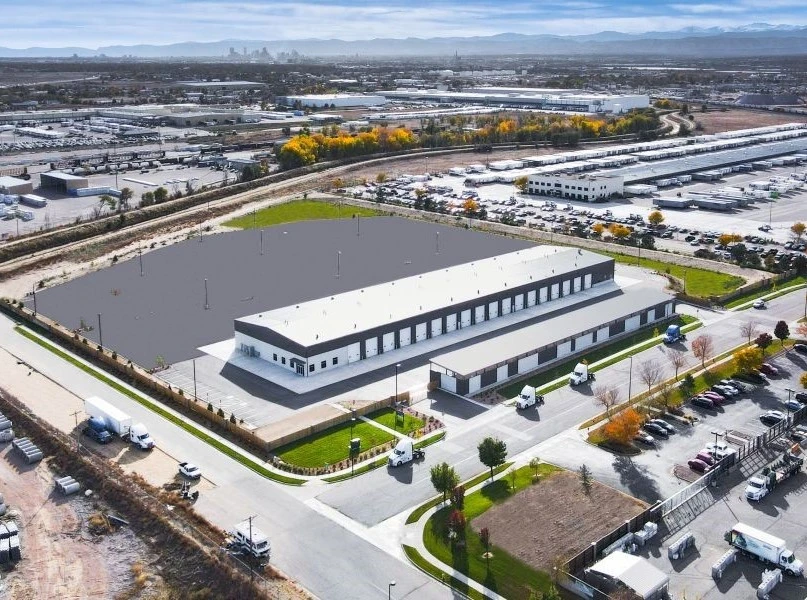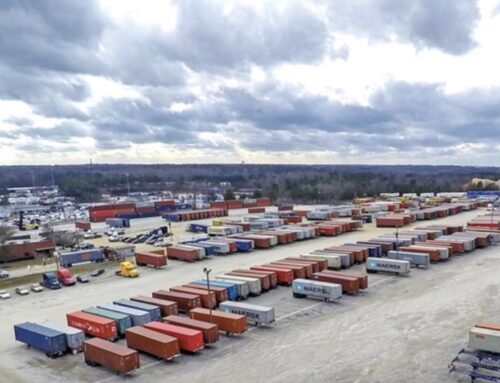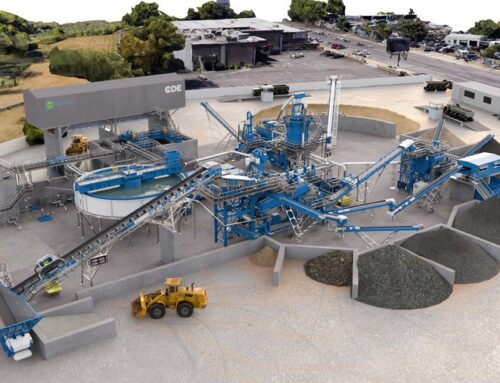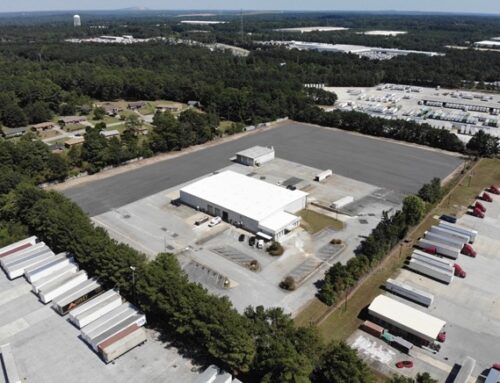Investor demand is being driven by strong operating results, a tight supply and minimal capital expenditure.

8780 E. 93rd Place, Commerce City, Colo. Image courtesy of Industrial Outdoor Ventures
Green Street calls the industrial outdoor storage subsector “a beautiful ugly duckling.” Marcus & Millichap calls it “last-mile industry’s highly demanded, yet underdeveloped cornerstone.”
Previously known as a niche within the larger industrial market, over the last several years IOS has grown to be at least a $200 billion market that is increasingly attracting institutional investors as well as real estate investment and development firms with specialized IOS operating platforms. One investor thinks $200 billion is a conservative estimate. It could be because the bigger players are building national portfolios nearing $1 billion in some cases and surpassing $2 billion in at least one case.
While ongoing economic uncertainty amid the rising interest rate environment has slowed down acquisition activity somewhat since late last year, IOS industry experts tell Commercial Property Executive demand and leasing remain strong and rent growth continues, albeit more slowly. And the good news is that IOS investors have seen an uptick in potential acquisition activity in the last several months.
“It was a little quiet but within the past 30 to 45 days, the phones are ringing off the hook again,” said Eric Johnson, senior vice president of development and acquisitions at Chicago-based Industrial Outdoor Ventures, one of the early movers in the IOS market that is nearing its goal of owning and managing more than $1 billion in such assets across the country.
In 2022, IOV completed 30 transactions with a total value of nearly $300 million, bringing its assets under management to about $800 million. The company has nearly 80 assets in 18 markets, including two new markets it entered last year—Maryland and New Jersey. It opened its first regional office in Denver and is looking to staff offices in the Southeast or Northeast later this year or early 2024.
Eric Johnson, Senior Vice President of Development & Acquisitions, Industrial Outdoor Ventures. Image courtesy of Industrial Outdoor Ventures
“We’ve stayed pretty consistent around our growth and where we wanted to invest and how we wanted to invest,” said Johnson, noting the company also has several ground-up projects in development and sold a newly completed 52,500-square-foot Class A maintenance and repair facility in Commerce City, Colo., in February. That is one common use for IOS properties, also known as Industrial Service Facilities (ISF), that are often found near ports, industrial corridors and transportation nodes.
Industrial outdoor storage properties are generally uncovered lots used to store large equipment, vehicles or materials. They’re often used as truck terminals, trailer and container storage, as well as construction or heavy equipment yards. Typical sites range from 2 to 10 acres, with a small building often less than 10,000 square feet, that can be used as an office or for storage. Demand for industrial storage space that accelerated during the pandemic is continuing as more companies seek last-mile storage and delivery sites. Rising fuel costs have also caused firms to focus more on consolidating operations, making infill IOS sites particularly attractive.
But the IOS subsector is still a fragmented industry, with more than half of the stock still owned by private investors and mom-and-pop operators, according to a recent Green Street report. That means opportunities for rent and NOI upside will continue to be available for those seeking IOS deals from smaller owners.
Investor demand has been driven by strong operating results, favorable long-term supply and demand dynamics and minimal cap-ex burden, Green Street’s Vince Tibone and Jessica Zheng write in their research report. They note IOS sites in infill submarkets are priced to deliver risk-adjusted returns that are superior to other commercial real estate property investments, including traditional industrial.
Constrained supply coupled with increasing demand mean overall vacancies are low and rents are increasing. Vacancy fell under 3 percent in mid-2022, below the historical average, according to a Marcus & Millichap report released in October.
Alan Pontius, Senior Vice President & National Director, Marcus & Millichap. Image courtesy of Marcus & Millichap
Alan Pontius, senior vice president & director in the industrial division of Marcus & Millichap, said the subsector has seen “generally higher rental growth since 2019.”
While the October Marcus & Millichap report noted IOS rents had advanced by nearly 30 percent on average since the end of 2019 versus a 24 percent increase for traditional industrial during the same span, Pontius told CPE rental growth has moderated across all asset classes since then. However, he stressed IOS continues to have superior supply-demand fundamentals and rents are not decreasing.
“I expect to see investor demand continue to grow throughout the years despite recessionary risk,” Pontius said.
Supply and demand in industrial outdoor storage
IOS industry executives say they are somewhat insulated from that recessionary risk because there has been ongoing demand from tenants and they generally buy in cash and finance after closing or when the properties are stabilized. In IOV’s case, they tap an established credit facility from CIBC Bank USA.
“That’s been a big key to our success, that relationship and not having to finance these acquisitions deal by deal and have financing contingencies. It’s really set us apart as great buyers and sellers as well. The brokerage community really appreciates that,” Johnson said.
Zenith IOS, a Brooklyn-based company that launched in late 2021, formed a $700 million joint venture in February 2022 with J.P. Morgan Global Alternatives and is aiming to create a national IOS portfolio worth $1 billion. Daniel Laub, COO & co-founder with CEO Ben Atkins, said they have made more than $350 million of investments through the joint venture. He said they are well on their way to hitting their $1 billion AUM goal though general market conditions may have slowed their plan to reach that number within 2 years of launch.
“We think the next few months are going to present opportunistic buying moments for us,” Laub said.
He noted sellers had been slow to adjust to pricing expectations—a theme common throughout the commercial real estate industry for the past year.
“What we’re seeing here now at Zenith is some of those apprehensions have started to normalize. I think people are re-engaging. People are normalizing that pricing today is not what pricing was eight to nine months ago. I think we should be able to make up for some of the slower times,” Laub told CPE.
For Zenith, having the joint venture from a major institutional investor like J.P. Morgan Global Alternatives has been a differentiator when it comes to acquisitions, he noted.
Pointing out that a lot of the sellers are private owners or small investors, he said working with a group like Zenith and J.P. Global Alternatives means the seller can have confidence they will do what they say they’re going to do.
Laub said Zenith initially started with a seed portfolio in Texas, Florida and a few Northeast assets. The company’s portfolio now has about 45 assets located in 20 markets from coast to coast.
“Today we own in California all the way to New York, down to Texas and Florida, up to Minneapolis, Chicago and everywhere in between,” Laub said. “We’re continuing to focus on major MSAs and then we’ll also look at what we consider strategic secondaries and business has been good.” Laub said Zenith has been successful in remaining diversified both in geography and tenant mix.
More growth for industrial outdoor storage
Alterra IOS, the IOS arm of Alterra Property Group, a Philadelphia-based real estate investment and development company, is nearing a portfolio with $2.5 billion in assets. Alterra IOS, which entered the subsector in 2016, owns more than 185 properties in more than 30 states. About $850 million in acquisitions were made in the past year.
The firm is seeking to raise $750 million in its latest IOS fund, IOS Venture III, according to published reports. Last year, the IOS Venture II fund closed at $524 million in commitments, well beyond its original fundraising goal of $400 million, from a mix of investors including pension funds, endowments, foundations, asset managers, family offices and high net-worth individuals.
Matthew Pfeiffer, Managing Partner & CIO, Alterra Property Group. Image courtesy of Alterra Property Group LLC
“As a first mover in the IOS space, Alterra has built a sourcing network that utilizes several different channels. We looked at more than $10 billion in IOS last year alone and we continue to add resources and relationships to that proprietary funnel,” said Matthew Pfeiffer, managing partner & chief investment officer at Alterra Property Group, the parent company of Alterra IOS.
Pfeiffer added that institutional investors recognize the core aspect of the business—an imbalance on supply and demand.
“What sets IOS apart from some other asset classes in real estate is that supply is structurally muted with municipalities not being incentivized to add new zoned land for outdoor storage. The structural limit on supply coupled with the fact that the majority of tenants need to locate in infill locations of major MSAs near respective demand generators, leads to pricing power with landlords,” Pfeiffer said.
“Beyond the favorable supply and demand dynamics, IOS also benefits from being a very low capital expenditure business translating into low frictional leasing costs to put new tenants in the space. Lastly, the tenant profile is largely credit and national under a NNN lease structure that further entices institutional capital’s interest in the space,” he told CPE.
In December, Alterra IOS Manager, on behalf of its discretionary private real estate client, acquired a 14-property portfolio of industrial outdoor storage assets across eight states for more than $86 million in a sale-leaseback deal with Heniff Transportation Systems. The portfolio is fully leased by Heniff, a national bulk transportation provider with nearly 100 locations across the U.S.
The eight states in the portfolio are Florida, Georgia, Illinois, Ohio, Tennessee, Texas, Louisiana and Alabama. The 14 mission-critical locations serve as terminals, maintenance shops and transload facilities in key industrial markets including Savannah, Ga.; Chicago; Dallas-Fort Worth; Houston; Memphis, Tenn.; Cincinnati; Mobile, Ala.; Lakeland, Fla.; and Lake Charles, La.
Asked if those are the kinds of transactions Alterra IOS will continue to seek out, especially in light of constrained supply of IOS assets, Pfeiffer said yes.
“As capital market dislocation persists, Alterra continues to offer tailored solutions to tenants via sale-leasebacks with our specific expertise in the IOS market, fully discretionary fund and long track record of executing in difficult markets,” he said.
Other new players are also looking to trucking to grow their platforms. In March, Green Point Partners launched a dedicated $500 million truck and trailer IOS platform by making a strategic investment in Semi-Stow, an Austin, Texas-based semi-truck parking and trailer storage operator. GCM Grosvenor is GreenPoint’s lead investor in the strategy, in part through funds managed on behalf of large U.S. pension funds.
The investment will provide capital for both Semi-Stow’s expansion and for the acquisition of a portfolio of semi-truck parking and trailer storage assets across the U.S., valued at $500 million or more. The platform has already closed on its first two purchases, with a total storage capacity for more than 1,000 semi-trucks and trailers, in the Houston and Dallas–Fort Worth markets.








